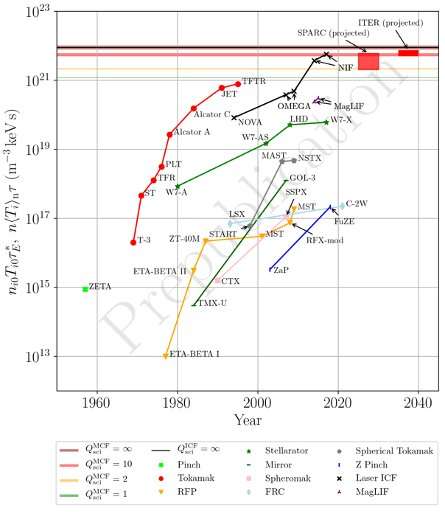Unveiling the steady progress toward fusion energy gain

The march towards fusion energy gain, required for commercial fusion energy, is not always visible. Progress occurs in fits and starts through experiments in national laboratories, universities, and more recently at private companies. Sam Wurzel, a Technology-to-Market Advisor at the Advanced Research Projects Agency-Energy (ARPA-E), details and highlights this progress over the last 60 years by extracting and cataloging the performance of over 70 fusion experiments in this time span. The work illustrates the history and development of different approaches including magnetic-fusion devices such as tokamaks, stellarators and other "alternate concepts," laser-driven devices such as inertial confinement fusion (ICF), and hybrid approaches including liner-imploded and z-pinch concepts.
A minimum condition for developing fusion research into a viable energy source for society is the achievement of large energy gain—that is, much more energy released due to fusion reactions than the energy put into the system in the first place. In 1955, a British engineer named J.D. Lawson identified the requirements for achieving high levels of energy gain: high temperatures, and a high product of density and energy confinement (or burn) time. Multiplying all three parameters into a single value called the "fusion triple product" gives a metric that allows for the comparison of different fusion concepts along the axis of energy gain. By extracting data from dozens of fusion journal articles and reports over the last six decades, Wurzel shows that progress was rapid from the 1960s to the 1990s.
Past the nineties, however, the increase in fusion triple product did not grow as steadily, but has jumped significantly in recent years in laser-based ICF at the National Ignition Facility (NIF), which has achieved the largest fusion triple product values to date. Newer, lower-cost concepts pursued by private fusion companies, like the sheared-flow stabilized Z-pinch and the field-reversed configuration (FRC) and other novel configurations are showing progress and promise, surpassing the performance of early tokamaks.
The key figures from Wurzel's invited tutorial talk, based on the manuscript by Wurzel and Hsu, provide a comprehensive framework, inclusive of all thermonuclear fusion concepts, for tracking and understanding the physics progress of fusion toward energy breakeven and gain (Figure 1).
More information: PT02.00001. Progress Toward Fusion Energy Breakeven and Gain as Measured Against the Lawson Criterion
Provided by American Physical Society




















